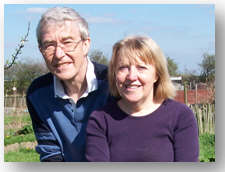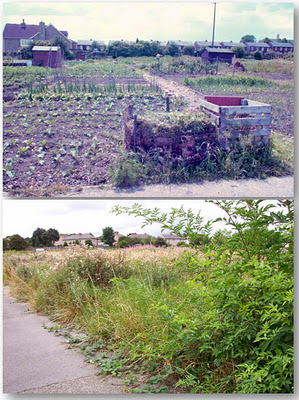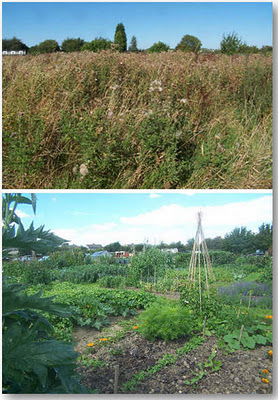

Home
About Us
Seed Suppliers
Manure Problems
Children's Pages
GLA Blog
Weather Blog
School Veg Patch
Useful Links
About Us
 Sometime in the 1980’s my husband suggested that we looked into taking on an allotment. We already had a vegetable patch in our garden but we wanted to grow more of everything - vegetables and flowers - and just didn’t have the space. At that time it was fairly easy to obtain an allotment quickly and we took on a plot on Green Lane as this was the nearest site to us with vacant plots. We set to work on the plot under the watchful eye of existing allotmenteers who were no doubt taking bets on how long we would last. The plot had been ploughed by the council which was a mixed blessing.
Sometime in the 1980’s my husband suggested that we looked into taking on an allotment. We already had a vegetable patch in our garden but we wanted to grow more of everything - vegetables and flowers - and just didn’t have the space. At that time it was fairly easy to obtain an allotment quickly and we took on a plot on Green Lane as this was the nearest site to us with vacant plots. We set to work on the plot under the watchful eye of existing allotmenteers who were no doubt taking bets on how long we would last. The plot had been ploughed by the council which was a mixed blessing.
 As I had anticipated I was one of a very small number of women to visit the plot to actually garden and our curiosity value was compounded by the fact that we grew ‘strange’ things such as herbs! The more established allotmenteers were often to be found surveying our plot, offering advice and asking, “What’s that then?”
As I had anticipated I was one of a very small number of women to visit the plot to actually garden and our curiosity value was compounded by the fact that we grew ‘strange’ things such as herbs! The more established allotmenteers were often to be found surveying our plot, offering advice and asking, “What’s that then?”
The plots on either side of ours were overgrown and so during our second year on site we decided to rent a second plot – I guess at this stage the consensus was that we were ‘stayers’. I looked after the planting on the first plot whilst my husband sorted out the new one. At this stage the council had abandoned the practice of ploughing plots but each year mowed any vacant plots once a year.
Over the next few years plots were abandoned and very few of the vacant plots were being taken on, so eventually we decided to take on a third plot. The only other plot adjoining ours that was being gardened was vacated and so for several years we gardened surrounded by a forest of weeds that relentlessly spread thistle, dock and other pernicious weed seeds onto out plot. The council had abandoned the idea of keeping vacant plots tidy by annual mow.
 We eventually decided that we would take a fourth plot – we knew that on this plot were some apple cordons and red, white and black currant bushes hidden somewhere under the sea of brambles and other perennial weeds that had grown to mammoth proportions. Over half of the site was overgrown and derelict. Not only would taking on plot four mean that we could access the long forgotten fruit trees and bushes but with rumours that the council were considering reassigning some of the land for other purposes it was important that as many plots as possible were cultivated.
We eventually decided that we would take a fourth plot – we knew that on this plot were some apple cordons and red, white and black currant bushes hidden somewhere under the sea of brambles and other perennial weeds that had grown to mammoth proportions. Over half of the site was overgrown and derelict. Not only would taking on plot four mean that we could access the long forgotten fruit trees and bushes but with rumours that the council were considering reassigning some of the land for other purposes it was important that as many plots as possible were cultivated.
Allotments having not yet become popular, our site having many derelict plots and the need to protect land from any redesignation we took on a fifth plot in 2005.
It may seem that in light of the fact that many local authorities have growing waiting lists for allotments, that to have five allotment plots is unfair but our present good fortune should be judged in the light of what has gone before. Our plots were adopted at a time when no-one wanted them and the future of our site was at risk. It has been extremely hard work to bring our plots into their present cultivated state and much money has been spent on them over the years to improve growing conditions. If we hadn’t adopted additional plots then our allotment site may well have ceased to exist so we feel justified in hanging on to the fruits of our labour.
Our site is now fully occupied. When plots become vacant they are in no way as overgrown as the plots that we adopted were, however, very often after an enthusiastic start new plot holders lose interest and leave. When visiting a well cultivated plot it is easy to become enthusiastic about growing your own vegetables but taking on an allotment means lots of hard work and commitment. It isn’t a quick fix to acquiring freshly grown fruit and vegetables but is a life changing activity that is well worth the time and effort dedicated to it.
Our Plot at Green Lane Allotments Blog | A Gardener's Weather Diary | School Vegetable Patch Website
© Our Plot on Green Lane Allotments - Please email me if you wish to use any of this site's content